新人教版七年级英语下册Unit9-教案
人教版七下unit9全英教案

人教版七下unit9全英教案Unit 9 Teaching PlanTeaching goals:1. Learn and use the key vocabulary and phrases in this unit.2. Understand and use the structure of "Whatshould/shouldn't/can/can't we do?" to make suggestions and express opinions.3. Develop students' speaking and listening skills through communicative activities.4. Cultivate students' cultural awareness by learning about different etiquette in different countries.Teaching procedures:Step 1: Warm-up1. Greet the students and check their homework.2. Show the students some pictures of people from different cultures and ask them to discuss what they notice about their outfits or behaviors. Encourage them to think about whether these behaviors are good or not.Step 2: Vocabulary building1. Present the new vocabulary in this unit, such as bow, hug, behavior, scissors, greeting, etc. Use pictures, gestures, and examples to help students understand the meanings.2. Give the students some practice exercises to consolidate the new vocabulary. For example, match the words with their meanings, complete the sentences with the correct words, etc.Step 3: Reading and listening1. Have the students read the text "Etiquette around the world" silently and underline the key information. Then discuss in pairs about what they have learned.2. Play the listening material for the students to listen and match the countries with their customs. After listening, check the answers with the whole class.Step 4: Speaking practice1. Divide the students into groups and have them discuss the questions in Activity 3 on page 64. Encourage them to express their opinions and give reasons for their choices.2. Role play: Have the students work in pairs and act out a conversation where they make suggestions about etiquette in different situations. For example, one student can be a visitor and the other can be a local person. They can discuss what the visitor should or shouldn't do.3. Group presentation: Assign each group a country and have them research and present on the etiquette customs in that country. They can use pictures, videos, and real-life examples to make their presentations more engaging.Step 5: Consolidation1. Have the students complete the exercises in the workbook to consolidate what they have learned in this unit.2. Review the key vocabulary and phrases with the students. Play some vocabulary review games, such as "Taboo", "Hot Seat", or "Charades".Step 6: Assessment1. Give the students a quiz to test their understanding of the vocabulary and grammar in this unit.2. Evaluate the students' speaking and presentation skills based on their performance in the role play and group presentation activities. Step 7: Homework1. Assign homework exercises from the workbook to reinforce what they have learned in this unit.2. Ask the students to write a short essay about their own culture's etiquette customs, comparing and contrasting them with those in other countries.。
人教版英语七年级下册Unit9教学设计

3.教师通过展示图片、播放短视频等方式,让学生初步感知本节课将要学习的内容,激发学生的学习兴趣。
(二)讲授新知
1.教师呈现本节课的重点词汇和短语,如:sleep, wake, read, write, talk, noise, always, never, often, usually等,并进行讲解、示范。
2.学生跟读、模仿,掌握词汇和短语的正确发音。
3.教师通过示例句型,如:“What do you usually do?” “I usually read books.”,引导学生学习一般现在时描述日常习惯。
4.教师针对语法点进行详细讲解,让学生了解一般现在时的构成和用法,并举例说明。
(三)学生小组讨论
2.学生通过阅读课文,培养自己的阅读理解能力,掌握寻找关键词、理解文章大意的方法。
3.学生通过写作练习,学会运用一般现在时描述日常习惯,并提高自己的写作水平。
4.学生在课堂活动中,学会自主探究、合作学习,培养解决问题的能力和创新思维。
(三)情感态度与价值观
1.学生通过学习本单元内容,认识到养成良好习惯的重要性,激发自己养成良好的日常习惯。
1.教师将学生分成小组,每组讨论一个日常习惯话题,如:生活习惯、学习习惯等。
2.学生在小组内用一般现在时分享自己的日常习惯,并讨论良好习惯对个人成长的意义。
3.各小组展示讨论成1.教师设计多样化的练习题,如:填空、选择、改错等,让学生巩固所学知识。
2.学生在语法方面,对一般现在时的运用还不够熟练,需要通过丰富的语境和实际操作来提高。
3.学生的听说能力有待提高,教师应设计多样化的课堂活动,激发学生的参与热情,提高他们的听说水平。
人教版七年级英语下册Unit9教学设计

3.交际教学法:鼓励学生积极参与课堂活动,与他人分享过去的事情,提高学生的口语表达能力。
4.情感教学法:关注学生的情感需求,营造轻松愉快的课堂1.培养对英语学习的兴趣和积极性,树立自信心。
c.小组合作:分组进行口语练习和写作任务,促进学生之间的互动交流,提高语言实践能力。
2.课堂教学活动设计:
a.热身活动:通过歌曲、游戏等形式,激活学生已有的知识,为新课的学习做好铺垫。
b.听力训练:设计不同难度的听力任务,让学生在听的过程中捕捉关键信息,提高听力理解能力。
c.口语练习:开展角色扮演、小组讨论等活动,让学生在实际语境中运用一般过去时态和频率副词进行口语表达。
3.教学目的:帮助学生巩固所学知识,提高学生的语言运用能力。
五、作业布置
为了巩固本章节的学习内容,提高学生的语言实践能力,特布置以下作业:
1.词汇练习:请学生完成课后单词和短语的抄写,每个单词或短语写三遍,并尝试用它们造句。此作业旨在帮助学生加深对词汇的记忆和理解。
2.语法练习:设计一般过去时态的填空题和改错题,要求学生完成并自我检查。通过此类练习,学生可以进一步熟悉一般过去时态的构成和用法。
c.推荐与过去活动相关的英语学习资源,鼓励学生进行自主学习。
4.教学评价:
a.形成性评价:关注学生在课堂活动中的表现,给予及时的反馈和鼓励。
b.总结性评价:通过单元测试,评估学生对一般过去时态和频率副词的掌握情况。
四、教学内容与过程
(一)导入新课
1.教学活动设计:教师播放一首关于过去的英文歌曲,引导学生关注歌词中描述的过去活动。歌曲结束后,教师邀请学生分享他们在歌曲中听到的过去发生的事情。
人教版《新目标英语》七年级(下册)九单元教学设计

导学案设计教材:人教版《新目标英语》七年级(下册)Unit9 What does he look like?Section B(2a-3b)一、课型:读写课二、学情分析学生在第七单元SectionA所学知识的基础上,仍旧围绕人物外貌描述展开活动,并进一步拓展话内容。
学生具有了学习本部分知识的认知前提,能自然地与本单元SectionB话题进行衔接。
三、教材分析1、教学内容本单元是Go for it七年级下册中第七单元“What does he look like?”。
本单元的核心话题是谈论人的外表形象(look), 教材内容围绕着描述人的外貌特点展开,让学生学会谈论人的身高、体重、发型、面部特征及着装特点,因此“Describe people’s looks”是教学重点。
通过对本单元的学习,学生能掌握本单元出现的表示人外观的词组及句型。
2、教材的地位及作用以人的外貌特征为主线,兼顾交际功能的学习,以一种循序渐进的生活化的学习程序,引导学生学会用英语介绍自己或他人的外表特征。
本单元的教学内容与学生的实际生活密切相关,易于引发学生运用简单的英语进行交际和交流。
在学习活动中,学生能通过交换对不同人物的描述及看法,促进学生之间和师生之间的情感交流,增进情谊,并培养学生合作学习的意识。
四、教学目标知识与技能目标1.语音:了解语音在语言学习中的意义。
2.词汇和短语:名词: hair, height,build,captain,team, bit, joke, beard,glasses,look, singer etc.形容词:short, tall, medium, thin, heavy, blonde, brown, curly, straight, wise, popular, huge,teeny etc.动词: wear, stop, remember, say etc.短语:straight hair, a medium build, look like, good-looking,a little bit etc.句型:What does he/she look like? He/She is tall. He/She has curly hair.What do you/they look like? I’m thin. /They’re medium height.Do you know David? No/Yes.语法:①Yes/No问句及简略回答②wear的一般现在时用法③用于宽泛描述的形容词3.能通过上下文确定阅读篇章中的指代关系。
七年级下册英语Unit9单元教案(人教版)
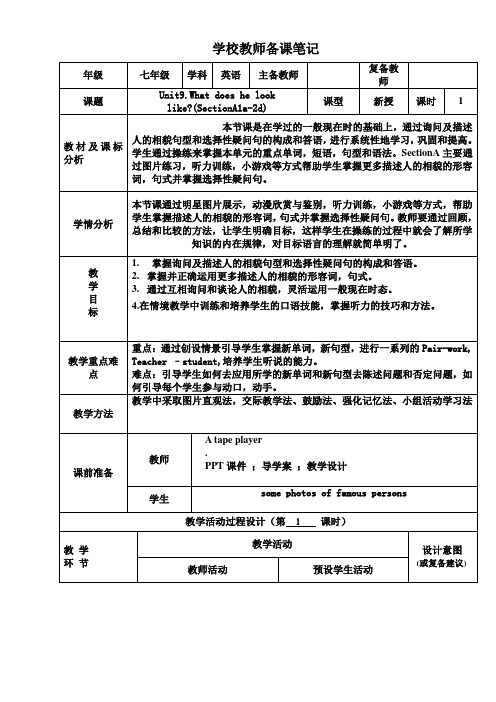
F:They are both tall with short curly hair.
教
学
反
思
学校教师备课笔记
年级
七年级
学科
英语
主备教师
复备教师
课题
Unit9.Whatdoes he look like?(SectionA:3a-3d)
Make conversations from the words in 1a .Then practice them in pairs
根据听力信息,从1a中选词编成对话,然后表演。
A:What does your friend look like?
B:She’s of medium height, and she has longstraight hair.
难点:引导学生如何去应用所学的新单词和新句型去陈述问题和否定问题,如何引导每个学生参与动口,动手。
教学方法
教学中采取图片直观法,交际教学法、鼓励法、强化记忆法、小组活动学习法
课前准备
教师
Atape player
.
PPT课件;导学案;教学设计
学生
some photos of famous persons
C: What about your friend?
D: He’s tall and thin with short curly hair.
E:Oh,really? I see.Thank you.
F:That’s OK.
根据听力与对话,请同学们自己随意问答。
1.Is David tall or short?
学校教师备课笔记
人教版英语七年级下册教案第九单元unit9 what does he look like
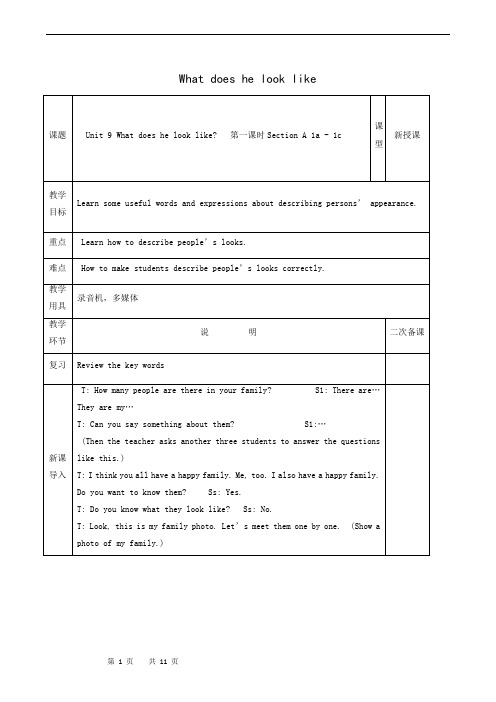
T: Look, this is my family photo. Let’s meet them one by one. (Show a photo of my family.)
Step 1 New words
1. Present new words.
课型
新授课
教学目标
1.To enable students to describe people’s looks correctly.
2.To improve students listening skill.
重点
How to improve students listening skill.
难点
How to make students describe people’s looks correctly.
What does he look like
课题
Unit 9 What does he look like? 第一课时Section A 1a - 1c
课型
新授课
教学目标
Learn some useful words and expressions about describing persons’ appearance.
重点
Learn how to describe people’s looks.
难点
How to make students describe people’s looks correctly.
教学用具
录音机,多媒体
教学环节
说 明
二次备课
复习
Review the key words
新人教版七年级英语下册Unit9 教案
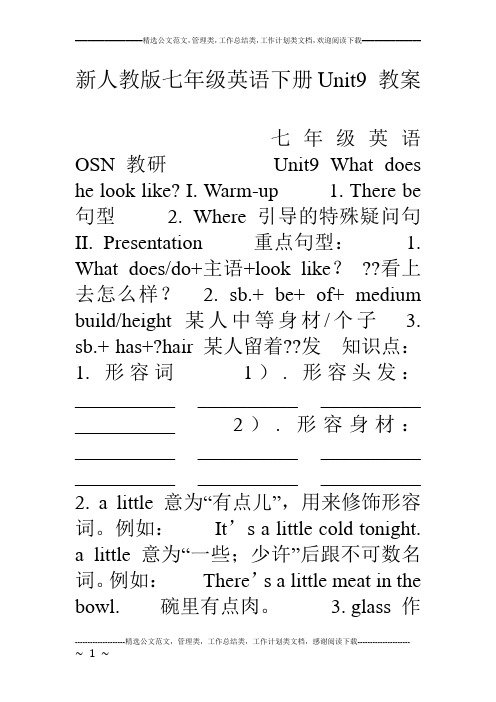
新人教版七年级英语下册Unit9 教案七年级英语OSN 教研Unit9 What does he look like? I. Warm-up 1. There be 句型 2. Where引导的特殊疑问句II. Presentation 重点句型: 1. What does/do+主语+look like???看上去怎么样? 2. sb.+ be+ of+ medium build/height 某人中等身材/个子 3. sb.+ has+?hair 某人留着??发知识点:1. 形容词1). 形容头发:__________ __________ __________ __________2). 形容身材:__________ __________ __________ __________ __________ __________ 2. a little 意为“有点儿”,用来修饰形容词。
例如:It’s a little cold tonight.a little 意为“一些;少许”后跟不可数名词。
例如:There’s a little meat in the bowl.碗里有点肉。
3. glass 作“玻璃”讲时,是不可数名词;作“玻璃杯”讲时为可数名词;而glasses则是“眼镜”之意。
例如:Glass is broken easily. There’s no water in your glasses. 玻璃很易碎。
你的杯子里没有水了。
Does she wear glasses?她戴眼镜吗? 4. describe people’s looks. 教师寄语:Victory won’t come to you unless you go to it. 胜利不会走向你,除非你走向它。
1 七年级英语OSN 教研Unit8重点短语看起来像____________________ 短发___________________ 卷发____________________ 中等个子___________________中等身材___________________一点;少量________________ 大鼻子________________小嘴________________圆脸________________警察画家________________ 一张罪犯的图片或肖像____________________________最后________________擅长________________去看电影____________________黑发________________长脸________________长发________________直发________________有点________________大眼睛________________同样的方式________________ 金黄色的头发____________________今晚你要去看电影吗?__________________________________ _____________ 我可能会有点迟__________________________________ _____________ 他不高不矮__________________________________ _____________ 人们并非总是以同样的方式看待事物,所以他们会将同一个人描述的不一样。
人教版七年级下册英语Unit9《Howwasyourweekend?》教案

人教版七年级下册英语Unit9《Howwasyourweekend?》教案《How was your weekend?》教案(一)教学目标1.认知目标:o能熟知课文主要内容,掌握相应的语言知识(单词、习惯用语、语法和功能用语)。
o能结合所给任务,综合运用新、旧知识完成任务。
2.技能目标o能培养良好的听、说、读、写的能力,能正确使用动词过去式进行准确的描述。
o通过观察、想象、模仿和表演等熟练、生动、有创造性地从图片或文字材料中获取有效信息,拓宽视野,围绕“上一周周末活动”进行交际。
o能在日常生活中恰当理解这单元话题范围内的单词和习惯用语,在真实的语言环境中体会语言,运用语言,感受语言的真实价值,品味语言的实际意义,从而获得运用语言的实际能力,运用所学知识进行创造性地发挥应用和积极主动地用英语进行交流。
3.情感目标o合理安排自己周末的学习、运动、休息、娱乐等活动形式,过有益义的周末。
保持愉快的心情,以积极的姿态,精神饱满地面对生活与学习。
教学重难点单词:beach,pool,visit,stay,cute,test,cook,spend,mountain,practice以及不规则变化行为动词is,do,go,have,read,see,write,sit的过去式形式was,did,went,had,read,saw,wrote,sat短语:go to(a place),go shopping,go for a walk with……,visit (a person),watch sb do sth,It is time to do sth,read a bookabout(history),see an interesting talk show,study for the(math)test。
教学工具课件教学过程Step1. Revision1. Check the past tense of some words.2. Practice “How was your weekend?”Step2. ExerciseAsk: What did you do yesterday?Let’s see what Sally and Jim did yesterday. Do 1a on P56.Do you like the things they did? Ask: Do you like to play the guitar? … .Listen and write down what Sally and Jim did last weekend and complete the chart.Step3. SurveyInterview your partners about their parents: What did your mother /father do last weekend? Then give us a report: My friend **’s father/mother … last weekend.Step4. ReadingRead 3a by yourself, and circle the activities you like. Underline the activities you don’t like. T hen let the students give their answers.Explain: For most kids.Then ask some students to read the passage.Step5. SurveyWhat did most of you do last weekend? Ask about your friends in your group and give a report:Last weekend, most of us … .Step6. ExerciseDo 3b. First ask questions about the pictures? What is he/she doing?Then fill in the blanks according to the pictures.Step7 Oral WritingCan you introduce your last weekend like 3b?Homework:1. Write about what you did last weekend.2.Do workbook(1) P35 (2)26课后小结学了这节课,你有什么收获?课后习题完成课后练习题。
人教版新目标七年级英语下册 Unit 9教学设计
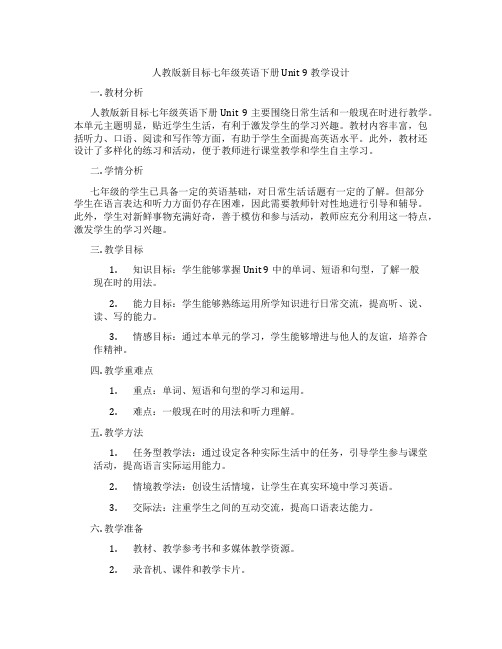
人教版新目标七年级英语下册 Unit 9教学设计一. 教材分析人教版新目标七年级英语下册Unit 9主要围绕日常生活和一般现在时进行教学。
本单元主题明显,贴近学生生活,有利于激发学生的学习兴趣。
教材内容丰富,包括听力、口语、阅读和写作等方面,有助于学生全面提高英语水平。
此外,教材还设计了多样化的练习和活动,便于教师进行课堂教学和学生自主学习。
二. 学情分析七年级的学生已具备一定的英语基础,对日常生活话题有一定的了解。
但部分学生在语言表达和听力方面仍存在困难,因此需要教师针对性地进行引导和辅导。
此外,学生对新鲜事物充满好奇,善于模仿和参与活动,教师应充分利用这一特点,激发学生的学习兴趣。
三. 教学目标1.知识目标:学生能够掌握Unit 9中的单词、短语和句型,了解一般现在时的用法。
2.能力目标:学生能够熟练运用所学知识进行日常交流,提高听、说、读、写的能力。
3.情感目标:通过本单元的学习,学生能够增进与他人的友谊,培养合作精神。
四. 教学重难点1.重点:单词、短语和句型的学习和运用。
2.难点:一般现在时的用法和听力理解。
五. 教学方法1.任务型教学法:通过设定各种实际生活中的任务,引导学生参与课堂活动,提高语言实际运用能力。
2.情境教学法:创设生活情境,让学生在真实环境中学习英语。
3.交际法:注重学生之间的互动交流,提高口语表达能力。
六. 教学准备1.教材、教学参考书和多媒体教学资源。
2.录音机、课件和教学卡片。
3.学生分组,准备角色扮演等活动。
七. 教学过程1.导入(5分钟)教师通过与学生打招呼,询问身体状况等日常话题,引入本课主题。
引导学生谈论日常生活中的一般现在时,激发学生学习兴趣。
2.呈现(10分钟)教师展示课件,呈现Unit 9的单词、短语和句型。
通过图片、例句等方式,对新词汇和短语进行讲解,让学生初步感知和理解。
3.操练(10分钟)教师学生进行口语练习,运用新学的单词、短语和句型进行角色扮演。
【更新】人教版七年级下册英语Unit9第九单元优秀教案
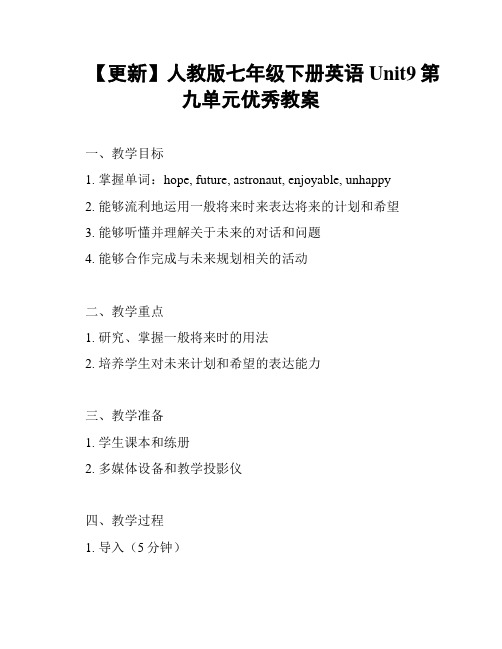
【更新】人教版七年级下册英语Unit9第九单元优秀教案一、教学目标1. 掌握单词:hope, future, astronaut, enjoyable, unhappy2. 能够流利地运用一般将来时来表达将来的计划和希望3. 能够听懂并理解关于未来的对话和问题4. 能够合作完成与未来规划相关的活动二、教学重点1. 研究、掌握一般将来时的用法2. 培养学生对未来计划和希望的表达能力三、教学准备1. 学生课本和练册2. 多媒体设备和教学投影仪四、教学过程1. 导入(5分钟)引导学生讨论一下他们的未来计划和希望,激发学生研究的兴趣和积极性。
2. 教学主体(30分钟)a. 复和引入新知识通过多媒体展示相关图片,引入新单词和短语,并帮助学生掌握其含义。
b. 教授一般将来时的用法详细解释一般将来时的构成和用法,例如:主语 + will + 动词原形。
通过示例句子和练帮助学生理解和掌握。
c. 练与拓展让学生进行口头和书面练,练运用一般将来时进行句子构造和对话。
同时,组织小组活动,让学生合作讨论自己的未来计划。
3. 巩固与反馈(15分钟)通过问题和对话练,巩固学生对一般将来时的掌握程度。
同时,对学生的合作活动进行评价,并给予反馈和鼓励。
五、教学延伸鼓励学生在家进行额外的练,巩固所学的知识。
可以提供一些相关的练题和研究资源。
六、教学评价通过对学生的口头和书面练进行评价,了解学生对一般将来时的掌握程度,并给予针对性的指导。
七、教学反思根据教学实际情况,对本节课的教学效果进行总结和反思,为下一次教学做出调整和提升。
八、课后作业完成课本和练习册上相关的练习题,并继续思考自己的未来计划和希望。
人教版七年级英语下册Unit9优秀教学案例

二、教学目标
(一)知识与技能
1.学生能够掌握疑问词how、what、where、when等的使用,并能用一般疑问句询问时间、地点、价格等方面的问题。
五、案例亮点
1.情境教学法的运用:本案例中,教师运用情境教学法,设计了多种生活情境,让学生在真实的语境中感受和理解一般疑问句的使用。这种教学方法有助于激发学生的学习兴趣,提高他们的口语表达能力和实际应用能力。
2.问题导向式教学:教师围绕单元主题设计了一系列问题,引导学生思考和探索。问题导向式教学有助于培养学生的思维能力和批判性思维,使学生在解决问题的过程中巩固所学知识。
在小组讨论结束后,我组织学生进行总结归纳。首先,我邀请几名学生分享他们小组编写的对话,让其他学生听后进行评价。接着,我引导学生总结出一般疑问句的构成要素和用法,以及如何用一般疑问句询问时间、地点、价格等方面的问题。通过这种方式,学生可以系统地复习和巩固所学知识。
(五)作业小结
在本节课的最后,我布置了一项作业,要求学生结合所学内容,编写一段对话,运用一般疑问句进行交流。同时,我还要求学生在对话中注意时态、语序等语法问题。这样,学生可以在课后继续巩固所学知识,提高自己的英语水平。
四、教学内容与过程
(一)导入新课
本节课的导入环节,我采用了图片导入的方式。首先,我在大屏幕上展示了一张购物场景的图片,让学生观察并思考:“你们在图片中看到了什么?”,“他们在做什么?”学生回答后,我接着提问:“如果我们想了解图片中商品的价格、颜色、尺码等问题,我们应该如何提问?”这时,学生可以回答出“我们可以用一般疑问句来提问”。通过这种方式,我成功地引导学生联想到本节课的主题——一般疑问句,激发他们的学习兴趣。
人教版七年级英语下册Unit9SectionA(2d3c)教学设计

教师将根据学生的作业完成情况,及时给予评价和反馈,鼓励学生持续进步,提高他们的英语素养。同时,教师应关注学生的作业负担,合理调整作业量,确保学生在轻松愉快的环境中学习英语。
(3)同伴评价:鼓励学生相互评价,培养他们的合作精神和批判性思维。
四、教学内容与过程
(一)导入新课
1.教师出示游乐园的图片,引导学生观察并提问:“What's this place? Have you ever been to an amusement park? What did you do there?”通过这些问题,激发学生的兴趣和好奇心,为新课的学习做好铺垫。
(四)课堂练习
1.教师设计听力和口语练习,让学生根据所听内容,运用一般过去时回答问题。
2.教师设计角色扮演活动,让学生在真实语境中运用所学词汇和句型进行交流。
3.教师布置写作任务,要求学生运用一般过去时描述自己在游乐园的经历,巩固所学知识。
(五)总结归纳
1.教师引导学生回顾本节课所学内容,总结一般过去时的用法和动词过去式的变化规律。
(3)能够理解并运用本节课所学的目标句型,进行问答和描述。
2.难点:
(1)正确运用一般过去时描述过去的事件,注意动词过去式的变化。
(2)在真实语境中,灵活运用所学词汇和句型进行情景对话。
(二)教学设想
1.针对教学重点,设计以下教学活动:
(1)利用图片和实物展示,引导学生学习和记忆核心词汇,提高他们的词汇运用能力。
(2)结合自己的生活经历,写一篇关于游乐园的短文,运用本节课所学词汇和句型,描述自己在游乐园的有趣经历。
2.口语作业:
(1)与家长或同学进行对话练习,运用一般过去时描述过去在游乐园的活动。
【精心编写】人教版七年级下册英语Unit9第九单元优秀教案
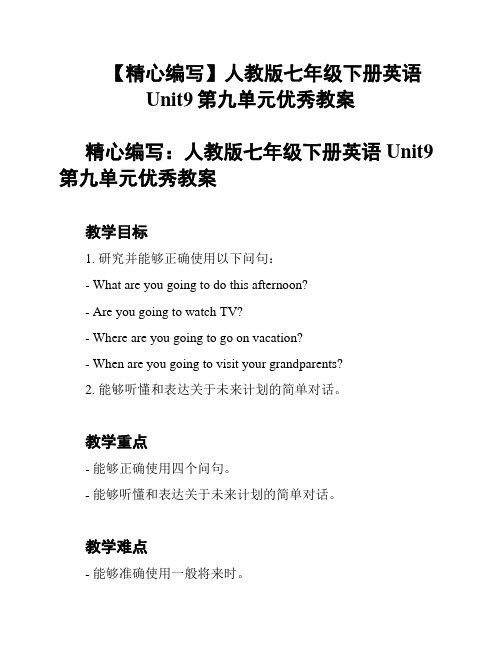
【精心编写】人教版七年级下册英语
Unit9第九单元优秀教案
精心编写:人教版七年级下册英语Unit9第九单元优秀教案
教学目标
1. 研究并能够正确使用以下问句:
- What are you going to do this afternoon?
- Are you going to watch TV?
- Where are you going to go on vacation?
- When are you going to visit your grandparents?
2. 能够听懂和表达关于未来计划的简单对话。
教学重点
- 能够正确使用四个问句。
- 能够听懂和表达关于未来计划的简单对话。
教学难点
- 能够准确使用一般将来时。
教学准备
教师准备课件,学生准备笔记和课本。
教学过程
导入新课
通过歌曲《Let's Talk About Future》(自选),引入新课内容,激发学生的研究兴趣。
学生跟唱歌曲,感受英语语言魅力。
展示新知识
在课件上展示四个问句,并讲解其用法和构造方法。
让学生进
行口语练。
练
1. 给学生一张工作表,完成其中的口语练。
2. 让学生自己编写对话使用所学问句,进行小组表演。
总结
复今天的研究内容,简要介绍一般将来时,让学生用自己的语
言给同桌讲解。
教学后记
本节课教学目标明确,操作简单易行。
学生在课上积极参与,课上练习及小组表演表现出色,达到了预期的教学效果。
人教版七年级英语下册第九单元同步教学设计

3.教师总结:教师强调本节课的重点知识,对学生的学习情况进行点评,鼓励学生在课后继续巩固所学,积极为自己的未来职业规划努力。
4.课后作业:布置与本节课相关的作业,如撰写一篇关于自己未来职业规划的短文,巩固课堂所学。
五、作业布置
教学设想:教师可以提供写作模板,引导学生梳理自己的思路。在写作过程中,关注学生的个体差异,给予针对性指导,提高学生的写作能力。
(二)教学设想
1.情境导入:通过展示不同职业的图片或视频,引发学生对未来职业的兴趣,为新课的学习营造氛围。
2.互动教学:在教学过程中,注重师生互动和生生互动,引导学生积极参与课堂活动,提高课堂活力。
(三)学生小组讨论
1.教学活动设计:教师将学生分成小组,每组选择一个职业主题,进行小组讨论。
2.讨论话题:各小组围绕所选职业主题,讨论以下问题:
- What are the qualifications and skills required for this job?
- What are the advantages and disadvantages of this job?
2.语法:学生能够理解并运用一般将来时,描述未来的计划和目标,以及不同职业的特点。
3.听力:学生能够听懂并理解与本单元主题相关的对话和短文,提高听力技巧,如:预测、关键词识别等。
4.口语:学生能够在小组讨论中,运用所学词汇和语法,流畅地表达自己对未来职业的期望和规划。
5.阅读与写作:学生能够阅读并理解与本单元主题相关的文章,学会从文章中获取信息、分析观点,同时能够撰写一篇关于自己未来职业规划的短文。
(二)过程与方法
人教版七年级下册英语教学设计:Unit 9 What does he look like-

人教版七年级下册英语教学设计:Unit 9What does he look like?一、教材分析本单元的教学核心项目是“描述人的外貌”(Describe People’s looks),涉及到讨论人的身高、体型、发型、面部特征及其着装等语言项目。
教材内容围绕着描述人的外貌特点展开,让学生学会谈论人的身高、体型、发型、面部特征及着装特点,以人的外貌特征为主线,兼顾交际功能的学习,以一种循序渐进的生活化的学习程序,引导学生学会用英语介绍自己或他人的外表特征。
这些内容与学生的实际生活密切相关,易于引发学生运用简单的英语进行交际和交流,所以在学习活动中,学生能通过交换对不同人物的描述及看法,促进学生之间和师生之间的情感交流,增进情谊。
二.教学目标1.知识目标a.学会描述人物外貌的词汇:hair,curly,straight,height,tall,medium,thin,heavy,build句型:-What does he/she look like-He/She is tall/short/of mediumheight/build/heavy/thin/ of medium build. He/She has long/short/straight/curly hair.b.能够抓住人物的主要特征来用英语描述人物的外貌形象。
c.能和合作伙伴互相交流,充分交换信息,进行合作学习。
2.过程和方法目标a.教会学生运用he/ she is … he/ she has…来描述人物的外貌。
b.教会学生运用what does he/ she look like这个特殊疑问句的用法。
3.情感态度与价值观:学会观察和描述周围的人物,学会友好地描述别人的形象,互相了解,增进友谊。
同时让学生明白不可以貌取人的道理。
三.教学重点及难点1.重点:1.掌握straight, curly, tall , short, of medium height/build, heavy ,thin等词汇。
最新人教版七年级英语下册第九单元教案
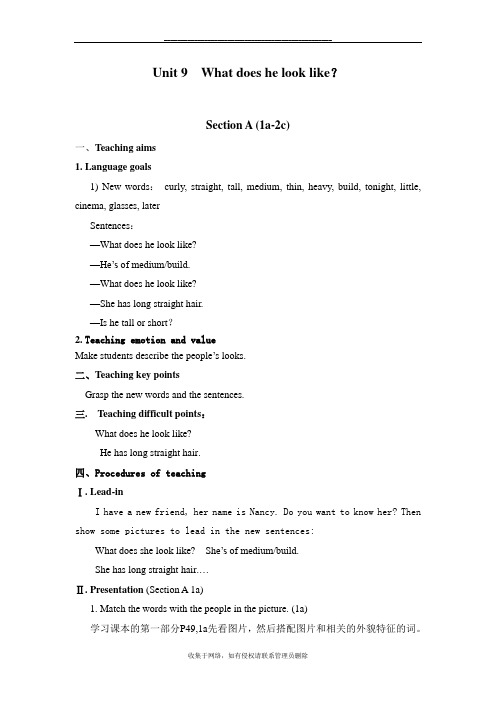
Unit 9 What does he look like?Section A (1a-2c)一、Teaching aims1. Language goals1) New words:curly, straight, tall, medium, thin, heavy, build, tonight, little, cinema, glasses, laterSentences:—What does he look like?—He’s of medium/build.—What does he look like?—She has long straight hair.—Is he tall or short?2. Teaching emotion and valueMake students describe the people’s looks.二、Teaching key pointsGrasp the new words and the sentences.三. Teaching difficult points:What does he look like?He has long straight hair.四、Procedures of teachingⅠ. Lead-inI have a new friend, her name is Nancy. Do you want to know her? Then show some pictures to lead in the new sentences:What does she look like? Sh e’s of medium/build.She has long straight hair.…Ⅱ. Presentation (Section A 1a)1. Match the words with the people in the picture. (1a)学习课本的第一部分P49,1a先看图片,然后搭配图片和相关的外貌特征的词。
新人教版七年级英语下册 Unit9 五课时-优质教案.doc

Unit 9 What does he look like? Section B (1a-1c)Teaching and Learning goals一、语言功能:Talk about the people’s looks and describe the people’s looks..二、语言知识:1熟练掌握以下词: artist, crime, criminal, put, each, way, describe, differently,another, end, real, in the end.2.熟练掌握以下句型:(1) They tell him what the criminal looks like.(2) The police put it in newspapers and on television to find him.(3) He wants to draw a good picture of each criminal.(4) Many people don’t always see things the same way so they ma y describe thesame person differently.三、学习策略:阅读策略1.依据文章题目和所给图片,预测(predicting)文章内容。
)2.通过略读(skimming)的方式,猜测文章大意。
3.借助关键词,通过寻读 (scanning)的方式,找寻细节内容。
4. 在阅读中尝试概括段落大意,加强篇章的整体理解。
四、情感态度:在阅读练习过程中,学生将会了解Joe Brown 有一份有趣的工作—警察艺术家这份工作的特点;并让学生能够准确的描述别人的外貌,让他们明白不要以貌取人。
Teaching and Learning stepsStep 1 预习检测一、Look at P53, put them into English orally, then write them down without looking at the text.1.一份有趣的工作 __________________2.一个警察艺术家 __________________3. 看到犯罪活动 __________________4. 通过电视 __________________5. 在报纸上 __________________6. 每一个罪犯 __________________7. 同样的方式 __________________8. 最后 __________________Answers: 1. a very interesting job 2. a police artist 3. see crimes 4. on television5. in newspapers6. each criminal7. the same way8. in the end【设计意图】这一部分是对学生预习内容的检测,通过学生抢答和默写,检测学生课下预习情况,预测学生掌握程度,有针对性的教,并让学生有针对性的学;帮助学生有目的性的学习,扫清本节课学习障碍。
人教七年级英语下册Unit9教学设计
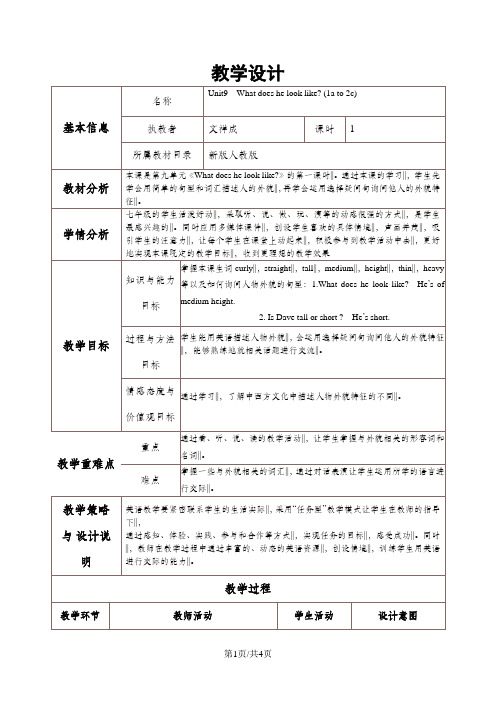
学生能用英语描述人物外貌||,会运用选择疑问句询问他人的外貌特征||,能够熟练地就相关话题进行交流||。
情感态度与价值观目标
通过学习||,了解中西方文化中描述人物外貌特征的不同||。
教学重难点
重点
通过看、听、说、读的教学活动||,让学生掌握与外貌相关的形容词和名词||。
难点
掌握一些与外貌相关的词汇||,通过对话表演让学生运用所学的语言进行交际||。
教学设计
基本信息
名称
Unit9What does he look like?(1a to 2c)
执教者
文祥成
课时
1
所属教材目录
新版人教版
教材分析
本课是第九单元《What does he look like?》的第一课时||。通过本课的学习||,学生先学会用简单的句型和词汇描述人的外貌||,再学会运用选择疑问句询问他人的外貌特征||。
通过ppt图片展示||,学生学习本课描述身高、体格的新词汇||。
通过ppt让学生认知如何描述人物的外貌||,应该使用哪一个动词||。
培养学生的观察能力||,进一步巩固理解所学描述人物外貌的词汇||。
通过多媒体课件展示引出本课的重点和难点||。自然而然地进行单词教固理解所学描述人物外貌的词汇和句型||。
课堂小结
2分钟
回顾本课教学内容||,描述人物外貌的词汇和句型||。
布置作业
1分钟
1.默写对话1c
2.默写单词
3.编对话||,完成2c.
板书设计
Unit9What does he look like?
单词句型
Curly --- straight1 ---What does he look like?
- 1、下载文档前请自行甄别文档内容的完整性,平台不提供额外的编辑、内容补充、找答案等附加服务。
- 2、"仅部分预览"的文档,不可在线预览部分如存在完整性等问题,可反馈申请退款(可完整预览的文档不适用该条件!)。
- 3、如文档侵犯您的权益,请联系客服反馈,我们会尽快为您处理(人工客服工作时间:9:00-18:30)。
Unit9 What does he look like?I.Warm-up1.There be句型2.Where引导的特殊疑问句II.Presentation重点句型:1.What does/do+主语+look like?……看上去怎么样?2.sb.+ be+ of+ medium build/height 某人中等身材/个子3.sb.+ has+…hair 某人留着……发知识点:1. 形容词1). 形容头发:__________ __________ __________ __________2). 形容身材:__________ __________ __________ __________ __________ __________2. a little 意为“有点儿”,用来修饰形容词。
例如:It’s a little cold tonight.a little 意为“一些;少许”后跟不可数名词。
例如:There’s a little meat in the bowl.碗里有点肉。
3. glass 作“玻璃”讲时,是不可数名词;作“玻璃杯”讲时为可数名词;而glasses则是“眼镜”之意。
例如:Glass is broken easily. There’s no water in your glasses.玻璃很易碎。
你的杯子里没有水了。
Does she wear glasses?她戴眼镜吗?4. describe people’s looks.看起来像____________________ 短发___________________ 卷发____________________中等个子___________________中等身材___________________一点;少量 ________________大鼻子________________小嘴________________圆脸________________警察画家 ________________一张罪犯的图片或肖像____________________________最后________________擅长 ________________去看电影____________________黑发________________长脸 ________________长发 ________________直发________________有点________________大眼睛________________同样的方式________________金黄色的头发____________________今晚你要去看电影吗?_______________________________________________我可能会有点迟_______________________________________________他不高不矮_______________________________________________人们并非总是以同样的方式看待事物,所以他们会将同一个人描述的不一样。
_______________________________________________Practice()1. —What_ ________ he ________ like? —He’s tall and thin.A. is; lookB. does; looksC. does; lookD. is; looks()2. There is _________ hair on her head.A. a fewB. a littleC. fewD. many()3. My father is a little fat. He loves _________ jokes.A. to tellB. tellC. to speakD. to sayUnit8重点短语Unit8重点句型()4. She always _________a red dress and white shoes.A. put onB. puts onC. inD. wears()5. Does he _________a new look?A. hasB. haveC. withD. in()6. Please stop _________.It’s time for meeting.A. to talkB. talkC. talkingD. talks()7. When you leave the room,please remember _________off(关掉)the light.A. turningB. turnsC. to turnD. turned()8. She’s a singer. She is good at_________.A. singingB. to singC. singsD. sang()9. The young man _________ glasses is my teacher.A. wearB. wearsC. put onD. with()10. He is new. Many people _________ him.A. doesn’t knowB. knowC. don’t knowD. knows()11. I don’t like country music,but my husband_________.A. doB. doesC. didD. is()12. There _________ nobody in the room.A. isB. areC. hasD. have()13. There is ______ milk in the glass, it’s _______ bad.A. a little, a little bitB. a little, a bit ofC. a little bit, a bit ofD. a little , little()14. The boy from America ______ long black hair.A. isB. hasC. withD. wears()15. Mrs Green has _______ hair.A. black long beautifulB. beautiful black longC. beautiful long blackD. a beautiful long black()16. My English teacher has a new __________.A. lookB. good-lookingC. hairD. glasses( ) 17. The woman _________ long hair is our math teacher.A. inB. withC. onD. of( ) 18. Mr Read on the bike _________ a medium build.A. haveB. hasC. areD. is( ) 19. Mr Brown doesn’t like pop songs , but his daughter _________.A. isB. likes C does .D. do( ) 20. That old man has ________ beard.A. aB. anC. theD./( ) 21. Pete stops _________ and goes to bed.A. watching TVB. watch TVC. to watch TVD. to read( ) 22. I often write emails to my pen pals , but ________ writes me back.A. everybodyB. somebodyC. anybodyD. nobody( ) 23. My aunt is too _________ ,she wants to be slim.A. heavyB. tallC. shortD. thin( ) 24. He is medium build , but he looks ________ fat, I think .A. a lot ofB. a bit ofC. a littleD. a little of( ) 25. I have __________ to tell you.A. important somethingB. something importantC. important anythingD. anythingimportant( ) 26. Can you _________ the differences between them?A. sayB. speakC. talkD. tell( ) 27. Please remember ________the window when you leave..A .closeB .closing C. to closing .D to close( ) 28. Jenny ________ her mother, and her mother _________ very young.A. looks ,like , looks likeB. looks like , looksC. looks , looks likeD. looks , looks( ) 29. -What does Lee look like? -He’s t all _________ blonde hair.A. in B .on C. with .D has( ) 30. The pretty girl has __________ hair.A. long brownB. brown longC. a long brownD. a brown long( ) 31. What about __________ shopping on Sunday? Good idea!A. goB. goesC. to goD. going过关检测过关时间:8min 满分: 10分得分:After school, Tom and Molly 1____. 2______father and mother are not at home. They are 3____ work. The two children see their white cat Rex is running 4_____ the floor. The cat is dirty. Molly wants to 5_____ it. She says to Tom, “let’s clean the cat 6______ the water.” Then Tom puts some water 7______ a washbasin. He catches the cat and puts it in the water. But the cat doesn’t like 8______ in the water. It jumps and jumps. Soon there 9_____ a lot of water on the floor. Then their father and mother come home. They see the water on the floor. They are not 10_____. They say to the children, “Don’t do that again!”牛刀小试Green: 1Tom: How can I get to the Supermarket, please?Green: I’m sorry I don’t know. You’d better ask the girl over there.Tom: 2(One minute later……)Tom: 3 , could you tell me the way to the Supermarket, please?Rose: Yes, I live near there.Tom: Is it far?Rose: No, not at all.Tom: But 4 ?Rose: Now walk along this street about two minutes. The Supermarket is over there between the school and the bookstore.Tom: Oh, I see. Thank you very much.Rose: You’re 5.Hello, my name is Lin Tao. 76 . There are nineteen boys and twenty-eight girls in my class. 77 His name is Sam Smith. He’s thirteen. He is tall and strong. 78 They are twin sisters. Their names are Kate and Joan. They are thirteen. Their mother Mrs. Miller is an English teacher of our school. They are my friends. They like playing badminton. 79 They like Beijing Opera very much, but they can only speak a little Chinese. 80 Our Chinese students all like the English boy and the American girls, and they like us, too.I’m Tony. My best friends are Frank and Cindy. We often do many things together. Frank lives next to my home and we are in the same class. He is thirteen years old and tall and medium build. He has curly hair and blue eyes. He’s good-looking and v ery clever. He’s good at math and often helps me with my homework. He likes wearing black pants and yellow T-shirts.Cindy doesn’t go to my school. She’s eleven years old. She is thin and medium height. She has curly blonde hair and her eyes are brown. She is good-looking, too, but a little bit shy. She is good at playing the guitar. Her favorite subject at school is music. She often teaches Frank and me to play the guitar after class.The three of us have great fun together, and we help each other and sometimes play video games at my house.1. What things do the three children do together? They ___________.A. play baseballB. play video gamesC. play the guitarD. both B and C2. _____________ eyes are blue.A. Frank’sB. Cindy’sC. MyD. Tony’s3. _______________ good at math.A. Frank isB. Cindy isC. I amD. Tony is4. ________________ is good-looking, but a little bit shy.A. FrankB. CindyC. TonyD. My friend5. Where do they play video games? _________________.A. at schoolB. at Frank’s houseC. at Cindy’s houseD. at Tony’s house根据下面的提示,用英语介绍这位同学。
